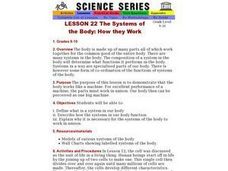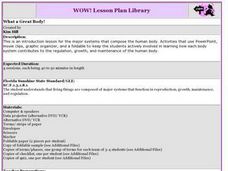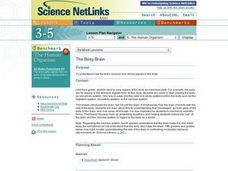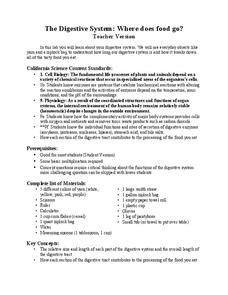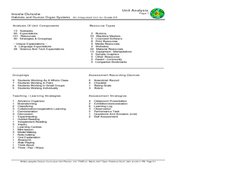Curated OER
The Digestive System
Sixth graders use the Internet to examine the human digestive system. Using a diagram, they identify and explain the functions of each organ involved in the digestion process. They complete an online activity as well to end the lesson.
Curated OER
Biomechanics of Sports
Students examine the body's major organ systems and how they function and influence each other. They examine how the human body moves when involved in sports.
Curated OER
Mind Games
Students design a prototype game as they simulate being game designers for a major corporation. They base the game on the major body systems.
Curated OER
Breathe In, Breathe Out
Students study the respiratory system, the lungs and air. In this respiratory instructional activity students describe technologies that engineers have found that improve the health of the respiratory system.
Curated OER
The Systems of the Body: How they Work
Students study what a body system is, how they function and how the systems work in unison.
Curated OER
It's My Body
Students research the human body. In this human body lesson, students brainstorm the connections between the parts of a bike and a human digestive system. Students work in small groups and research a specific body system. Students then...
Curated OER
Organ Systems: Excretory, Digestive, Immune, and Nervous
Eighth graders identify and describe the components of various body systems. They create vocabulary flash cards identifying the excretory, digestive, immune, and nervous systems and describing their functions. Students complete a...
Curated OER
Systems Working Together
Fourth graders practice reading in the content areas (science) in order to explore the interdependence of the body systems. They answer written questions after reading.
Curated OER
What a Great Body!
Students use PowerPoint, movie clips, graphic organizers, and a foldable to research and display information about how each body system contributes to the regulation, growth, and maintenance of the human body. Additional links and...
Curated OER
The Busy Brain
Students explore biology by completing a human body worksheet. In this human brain lesson, students identify the different anatomy within the brain and the functions those pieces form. Students read an article about signals in the brain...
Curated OER
The Human Skeletal System: Inside and Out
Students study bone size, structure and shape. They use various geometrical shapes to make a skeleton and produce a poster depicting the skeletal system and its functions. They arrange the pictures into the five sections, glue on...
LABScI
The Digestive System: Where Does Food Go?
Would you believe that your digestive system stretches to five times your height?! Help your pupils to understand this relationship as they work through the laboratory exercise. The first instructional activity of a 12-part series is a...
Curated OER
The Human Body, Incorporated
Second graders research each body system and writer a letter t Joe, the CEO of the Human Bdy, Incorporated, who is downsizing. In their letter, 2nd graders tell him which body parts to keep as employees.
Curated OER
Skeletal, Skin, and Muscular Systems
Eighth graders explain the functions of various body systems. Using a concept map, 8th graders identify and explain the fuctions of the skeletal, skin, and muscular systems of the body. After completing their concept map, students...
Curated OER
Exploring the Nervous System Through Disease and Injury
Students are introduced to the nervous system. In groups, they research the relationship between disease and injury and how it affects the nervous system. To end the lesson, they present their findings to the class and create a poster.
Curated OER
Inside Outside: Habitats and Human Organ Systems
Learners examine the way habitats and human organ systems function. In groups, they role play the role of a government group assigned to determine if a settlement can make their home in a specific area. They must discover how humans and...
Tracy Pendry
Cardiovascular/Circulatory System
Explore the circulatory system with a cardiovascular pump activity that promotes discovery and discussion as class members create a functioning model of the heart. Continue the learning process through a web quest showcasing the...
Curated OER
Muscular and Skeletal Systems
How do muscles move bones? Find out using a built-in-class model. Pupils construct a hand model with paper and string, then follow a series of directions to explore the movement process. Discover additional information about the muscular...
Curated OER
From Human Skeletons to Owl Pellets to Paleontology
Students explore about the function of the skeleton and comprehend the names of the bones of the human skeleton. They compare bones of the human skeleton to a dinosaur skeleton and graph to compare these bones. Students sort bones to...
Rochester Institute of Technology
Artificial Lung and Diaphragm
She had a terribly busy day converting oxygen into carbon dioxide; now she just needs a moment to breathe. In the activity, scholars review the function of the respiratory system and discuss bioengineering's role in medicine/health and...
Curated OER
EXPLORING OUR HUMAN BODIES
Students observe and investigate the human skeletal and muscle systems. They become aware of the versatility of movement as well as gain experience through the use of diagrams and hands on activities. An extensive vocabulary is covered...
Baylor College
Heart and Circulation: Pre- and Post-Assessments
Middle schoolers demonstrate what they know about the structure and function of the heart and blood vessels. A set of 15 multiple-choice questions also addresses how the heart handles microgravity and how animals without...
Pennsylvania Department of Education
The Digestive System
Fourth graders simulate how the digestive system works. In this hands-on simulation, 4th graders complete six group activities that help students visualize how our body breaks down food into nutrients.
Nemours KidsHealth
Male Reproductive System
Young pupils are introduced to the male reproductive system, the process of reproduction and conception through worksheets, discussion, and instructional guidance.




